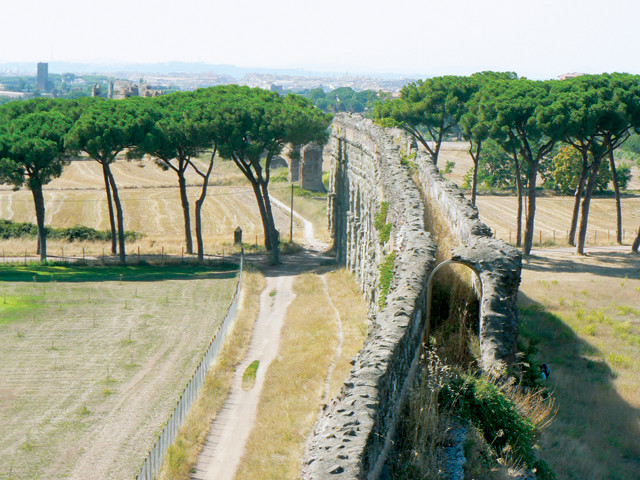
by Mary Caperton Morton Thursday, October 8, 2015

The Anio Novus aqueduct, which now lies in ruins, once supplied Rome with copious amounts of water. Credit: Duncan Keenan-Jones.
By the third century, Rome had 11 aqueducts — engineered rivers enclosed by masonry — that supplied water to more than a million people in the metropolis, as well as to the city’s many extravagant public baths and fountains. But just how much water was being sourced from distant rivers, lakes and mountain springs has long been a mystery. Now, scientists are putting some impressive numbers to ancient Rome’s water usage based on a study of travertine deposits that built up over time in the Anio Novus aqueduct as freshwater flowed through it to the city.
The Anio Novus aqueduct, built between A.D. 38 and 52, was the longest of Rome’s aqueducts, transporting water 87 kilometers from the Aniene River in the Apennine Mountains to the city. “Some sections of this aqueduct were more than 30 meters high. It was absolutely stunning from an architectural and an engineering point of view,” says Robert Rodgers, a professor of classics at the University of Vermont who was not involved in the new study. “This aqueduct was really one of the wonders of the ancient world.”
Scholars have long been interested in the Anio Novus system not just because of its sheer size, but also its written history: In A.D. 97, Rome’s water commissioner Sextus Julius Frontinus detailed the operations of the Anio Novus aqueduct in a text entitled “De Aquis.”
“Frontinus’ work is a fantastic resource that describes the aqueduct and its different pipes and the distribution system around the city in great detail,” says Duncan Keenan-Jones, an archaeologist at the University of Glasgow in Scotland and lead author of the new study published in the Journal of Archaeological Science. “It’s quite rare to have such detailed measurements from antiquity, and scholars have really tried to use them to calculate flow rates. But it’s clear Frontinus’ estimations were wildly off,” he says.
Frontinus calculated the amount of water flowing into Rome through the aqueducts using a unit of measurement called quinaria that was “based on the size of the pipes,” but he lacked a way to accurately measure the velocity of the flow rate through the pipes, Keenan-Jones says.
Much of the Anio Novus aqueduct lies in ruins today, but Keenan-Jones and his colleagues were able to take measurements of the travertine deposits still encrusted on the inside of an intact section of the pipe near Roma Vecchia, about 12 kilometers southeast of the city. The buildup of travertine within the channel recorded the average water level in the pipe, called the wetted perimeter. And in this location, travertine lined the entire pipe, indicating that the aqueduct was almost always full of water.
Based on known rates of travertine mineralization, the team found that the pipe must have had an average flow rate of 1.4 cubic meters (370 gallons) per second. At that rate, the aqueduct would have supplied Rome with roughly 121,000 cubic meters (nearly 32 million gallons) of water each day, an impressive flow rate even by modern plumbing standards, Keenan-Jones says.
Researchers have previously attempted to estimate the population of Rome based on the amount of water flowing into the city, but Rodgers warns against such correlations. “There were a lot of different uses for the water that don’t strictly represent the number of people using it,” he says. “Most ordinary citizens would have gone to the corner fountain and [retrieved] a pail or two a day, while the wealthy and the large public baths used vast quantities of water.”
Keenan-Jones says he and his colleagues would next like to determine which parts of the city were using the water supplied by the Anio Novus aqueduct, which was valued because it came from mountain springs, rather than rivers or lakes. “This was prized water,” Keenan-Jones says. “It’ll be interesting to see how it was diverted to serve the wealthier houses and more elite baths.”
© 2008-2021. All rights reserved. Any copying, redistribution or retransmission of any of the contents of this service without the expressed written permission of the American Geosciences Institute is expressly prohibited. Click here for all copyright requests.